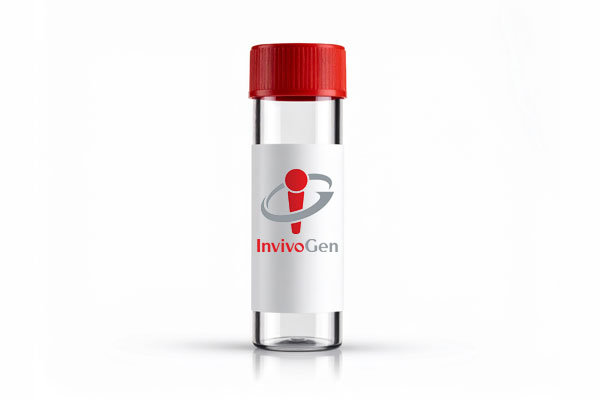
pUNO1-hTLR1-GFP
-
Cat.code:
phtlr1-gfp
- Documents
TLR1-GFP fusion gene was generated by fusing the green fluorescent protein (GFP) gene to the C terminus of human Toll-like receptor 1 (TLR1) gene. This fusion protein can be used to study the localization of TLR1.
Transfected cells can be analyzed for GFP expression by flow cytometry and by Western-blotting using GFP antibodies. The TLR1-GFP fusion gene is cloned in the pUNO plasmid under the control of the strong and ubiquitous mammalian promoter EF1α/HTLV.
hTLR1::GFP fusion gene has been fully sequenced, its fluorescence confirmed and its function tested in HEK293 cells coexpressing an NF-κB reporter plasmid (pNiFty-SEAP).
Specifications
Human TLR1::GFP fusion gene (3212 bp)
Selectable with Blasticidin in both E. coli and mammalian cells
Contents
- 20 µg of lyophilized DNA
- 2 x 1 ml blasticidin at 10 mg/ml
![]() Product is shipped at room temperature.
Product is shipped at room temperature.
![]() Lyophilized DNA should be stored at -20°C. Upon receipt, store blasticidin at 4°C or -20°C.
Lyophilized DNA should be stored at -20°C. Upon receipt, store blasticidin at 4°C or -20°C.
![]() Resuspended DNA should be stored at -20°C and is stable for up to 1 year.
Resuspended DNA should be stored at -20°C and is stable for up to 1 year.
![]() Blasticidin is a harmful compound. Refer to the safety data sheet for handling instructions.
Blasticidin is a harmful compound. Refer to the safety data sheet for handling instructions.
Details
No direct ligands have been identified so far for Toll-like receptor 1 (TLR1) which seems to act as a coreceptor for TLR2. TLR1 and TLR2 form heterodimeric complexes on the cell surface and in the cytosol. TLR1 and TLR2 interact to recognize triacylated lipopeptides [1] such as Pam3CSK4, but not diacylated lipopeptides [2].
The hTLR1::GFP fusion gene was generated by fusing at the C terminus of the human TLR1 gene to a GFP variant. A synthetic intron was added between both moieties to increase the activity of GFP. This hybrid protein absorbs blue light (major peak at 480 nm) and emits green light (major peak at 505 nm).
The hTLR1::GFP fusion gene is under the control of the strong and ubiquitous hEF1/HTLV promoter. This composite promoter comprises the Elongation Factor-1α (EF-1α) core promoter [3] and the R segment and part of the U5 sequence (R-U5’) of the Human T-Cell Leukemia Virus (HTLV) Type 1 Long Terminal Repeat [4]. The SV40 late polyadenylation signal enables efficient cleavage and polyadenylation reactions resulting in high levels of steady-state mRNA.
1. Takeuchi O. et al. (2002). Cutting edge: role of Toll-like receptor 1 in mediating immune response to microbial lipoproteins. J Immunol, 169(1):10-4.
2.Takeuchi O.et al. (2001). Toll-like receptors; their physiological role and signal transduction system. Int Immunol, 13(7):933-40.
3. Kim et al. (1990). Use of the human elongation factor 1 alpha promoter as a versatile and efficient expression system. Gene 2: 217-223.
4. Takebe et al. (1988). SR alpha promoter: an efficient and versatile mammalian cDNA expression system composed of the simian virus 40 early promoter and the R-U5 segment of human T-cell leukemia virus type 1 long terminal repeat. Mol. Cell Biol. 1: 466-472.
DOCUMENTS
Documents
Technical Data Sheet
Safety Data Sheet
Plasmid Map and Sequence
Certificate of analysis
Need a CoA ?